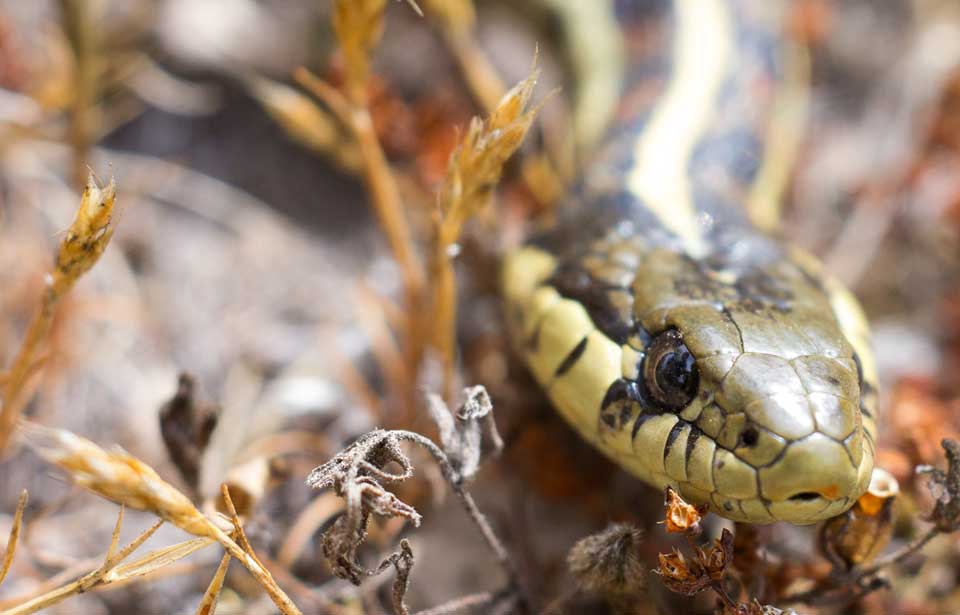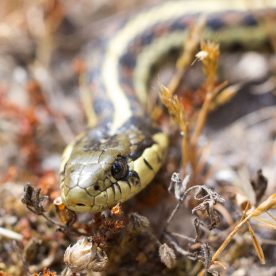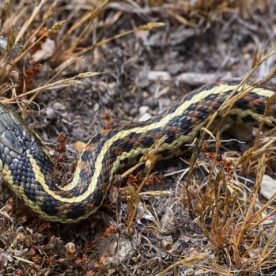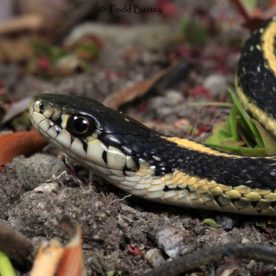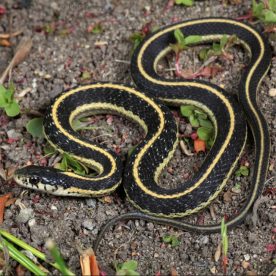Description
The western garter snake (Thamnophis elegans) is a medium-sized snake with a fairly robust body and long tail. From nose to tip of tail adults can measure between 460-960 mm and females are larger than males.
The head of the western garter snake is large and distinct from its neck. Its crown is black or brownish, depending on which part of western Canada the snake is located. The snake’s upper lip, chin and throat are white or yellow and its eyes are moderately large with a round pupil.
Sometimes the western garter snake is mistaken for the gopher snake or other garter snakes. A standard way to tell the difference between garter snake species is to look at scale patterns. The western garter snake generally has 10 lower lip scales, and eight upper lip scales. Other garter snakes usually have seven scales on the upper lip. Also, the sixth and seventh upper lip scales are usually enlarged (taller than they are wide). At mid-body, this snake has 21 rows of body scales and only a single anal plate. The scales on its back are keeled — ridged instead of smooth.
Colours vary with individual snakes, but the prominent yellow to orange stripe running down the western garter snake’s back is easiest to see. There are two lateral stripes on either side of its body — on the 2nd and 3rd rows of body scales — that are similar in color to the stripe down its back. In the space between stripes, the western garter is marked with dark spots or light specks. Like its head, its body has a grayish-green or black to dark brown colour.
The western garter snake has a grey or beige underbelly colour that may have dark spots, or a dark underbelly with white flecks concentrated down the mid-line.
Habitat and Habits
The western garter snake tends to inhabit open forest and grassy areas, preferring meadows and estuaries. Found in habitats ranging from desert riparian areas to mountain lakes and meadows, it is rarely found far from water where it both hunts and hides if disturbed. It can be found from sea level to 3,200 metres in elevation.
If looking for a western garter snake, the best time of day to spot one in early or late summer is mid-day when it is basking in the sun, whereas during the heat of mid-summer your best bet is to look in the early morning. It is a diurnal snake, active only in the warm hours of the day. This species hibernates communally in colder areas, sometimes with the common garter snake. The length of its inactive period varies with the local climate.
The western garter is a very active snake that sometimes bites if captured. It will also emit foul-smelling liquid from its cloacal glands near its base when captured. Unusual for Thamnophis, the western garter snake has been known to grapple with adult rodents like constrictors, coiling its body around the prey. This is probably not constriction but a method of restraining potentially dangerous prey. Also, this species of garter snake’s saliva is reportedly mildly poisonous to its prey.
Range
The second most widely distributed garter snake in Canada, the western garter snake can be found from southern British Columbia and Alberta east to southwestern Saskatchewan all the way south to central New Mexico and west into central California.
There are six species of garter snakes found throughout Canada, in addition to the western garter snake, which are: the common garter snake (Thamnophis sirtalis), which lives all the way from the Northwest Territories down to British Columbia and the U.S. and east to the Maritimes; the Butler’s garter snake (Thamnophis butleri) found in Southwestern Ontario south to Ohio; the eastern ribbon snake (Thamnophis sauritus) found in Southern Ontario, Nova Scotia and south to Florida; the northwestern garter snake (Thamnophis ordinoides) from Vancouver Island, southwestern British Columbia south to California; and the plains garter snake (Thamnophis radix), which lives in southern Alberta, Saskatchewan and Manitoba south to New Mexico.
Feeding
The western garter snake has one of the most varied diets of all Canada’s native snakes, allowing it to live in so many different regions. It eats soft-bodied invertebrates such as slugs, worms, snails, leeches, as well as tadpoles, frogs, other snakes, mice and freshwater and marine fish. Some coastal western garter snakes can satisfy their entire diet with fish from aquatic environments such as low tidal pools. The western garter snake has also been known to eat small birds and carrion.
Breeding
The western garter snake mates in the spring at or near hibernating sites, although fall mating has also been reported. Like all garter snakes, the western garter snake produces live young, rather than laying eggs, in litters of 1-24. The offspring are born from July to September and the newborns measure roughly 171-230 mm in length.
Although the young may be found near their mother after birth, no parental care is given and they soon fend for themselves.
Conservation
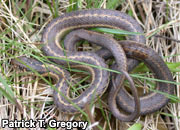
The main threat to western garter snakes is habitat loss, both to their summer and winter habitats. Pesticide use is also a concern since it harms snakes and poisons their prey. Snake road kills also have an impact because snakes seek the heated asphalt to warm their cold-blooded bodies.
What you can do
It is important to leave or create habitat suitable for snakes. You can do this in your own backyard by leaving a quarter of your garden wild, which provides damp, shady areas for snakes to cool off in the summer. Also, snakes like a warm sunny environment with lots of places to hide. Provide some rock piles and logs around ponds and gardens to offer these creatures shelter and protection from predators. Put some of the rock piles in sunny areas to provide a place for basking in the sun. Finally, you can try your hand at building a hibernaculum, which provides a safe location for snakes to hibernate.
Resources
Scientific reviewer
Dr. Patrick T. Gregory,
University of Victoria
Online resources
Idaho museum of natural history, Western Garter Snake
Gartersnake Info, Western Garter Snake
CWF’s Wild About Snakes poster
Print resources
Canadian Skin & Scales: a complete encyclopedia of Canadian reptiles & amphibians
Pat E. Bumstead
Simply wild publications, Calgary, 2003
Peterson Field Guides – Reptiles and amphibians
Conant, Stebbins, and Collins
Houghton Mifflin Company, Boston, 1992
The Snakes of Canada
Barbara Froom
McClelland and Stewart Lmt., Toronto, 1972
Amphibians and Reptiles of British Columbia
Brent M. Matsuda, David M. Green and Patrick T. Gregory
Royal BC Museum, Victoria, 2006



